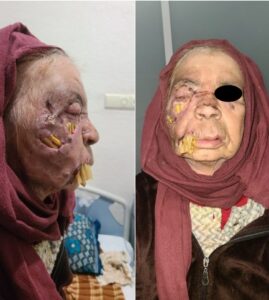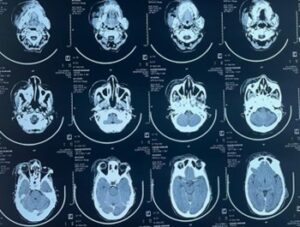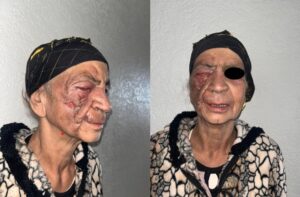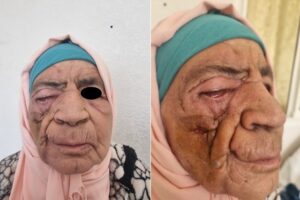Mohamed Afellah¹*, Hind Boukaaba², Guennoun Oumaima²,Anouar El youbi¹, Taha Jazzar², Naouar Ouattassi¹, Mohamed Ridal¹, Najib Benmanssour¹, Dounia Kamal², Mohamed Nourddine Elalami¹
¹Department of Otorhinolaryngology, Hassan II University Hospital of Fez, Morocco
²Department of Oral and Maxillofacial Surgery, Hassan II University Hospital of Fez, University Sidi Mohamed Ben Abdellah (USMBA), Morocco
*Correspondence author: Mohamed Afellah, Department of Otorhinolaryngology, Hassan II University Hospital of Fez, Morocco;
Email: Mohamed.afellah@gmail.com
Published Date: 04-11-2024
Copyright© 2024 by Afellah M, et al. All rights reserved. This is an open access article distributed under the terms of the Creative Commons Attribution License, which permits unrestricted use, distribution, and reproduction in any medium, provided the original author and source are credited.
Abstract
Necrotizing fasciitis is a rare but potentially serious and fatal infection. It is a dermo-hypodermitis with necrosis of the superficial fascia, typically caused by Streptococcus pyogenes. However, rare cases of fungal necrotizing fasciitis have been reported. We report the case of a 65-year-old type II diabetic patient who developed necrotizing cellulitis of the right hemiface with homolateral orbito-palpebral extension. The initial management was based on drainage of purulent collections with resection of necrotic tissues associated with parenteral antibiotherapy without clinical improvement. Bacteriological sampling revealed the presence of yeast. The mycological examination was positive for Candida albicans resistant to fluconazole. Antifungal treatment with intravenous amphotericin B was initiated with good clinical progression and complete remission after 1 month. The aim of this paper is to highlight the importance of promptly considering this diagnosis and extending the initial assessment of necrotic skin lesions to include mycological examination to detect severe forms of cutaneous candidiasis.
Keywords: Necrotizing Fasciitis; Fungal; Management; Candida; Amphotericin B
Introduction
Necrotizing fasciitis is a dermo-hypodermitis with necrosis of the superficial fascia [1,2]. This conditionmainly affects the limbs or trunk. The face and neck region are rarely involved [3,4]. The most frequently implicated pathogen is Group Aβ-hemolytic Streptococcus, but it is often a polymicrobial infection involving co-infection with anaerobic bacteria.
It mainly affects individuals with conditions that compromise the immune system, exposing them to a high risk of infection, particularly diabetes.Its rapid and severe progression can compromise the patient’s prognosis, leading to a high mortality rate. The prognosis depends on early diagnosis and treatment. Necrotizing fasciitis caused by fungal infection is extremely rare. We report a rare case of necrotizing fasciitis of the face secondary to a Candida albicans fungal infection in a diabetic patient.
Case Report
A 65-year-old female with a history of type II diabetes on oral antidiabetics was presented to the emergency department for the management of necrotizing fasciitis of the right hemiface associated with homolateral orbital cellulitis, which had been evolving for 15 days. Clinical examination on admission revealed erythematous, infiltrated, warm and painful patch with ulceration and necrotic areas involving the entire right hemiface, accompanied by significant inflammatory palpebral edema. Furthermore, the patient reported a history of minor facial trauma occurring a few days prior.
Laboratory values at the time of his admission included a white blood cell count of 27 000/mm3, a C-reactive protein level of 83 mg/L with impaired renal function that normalized after intravenous hydration measures. At the same time, a facial Computed Tomography (CT) scan was performed, which showed extensive infiltration of the right frontal, palpebral and jugal subcutaneous soft tissues, fusing to the contralateral jugal soft tissues with infiltration of the right pre-septal and retro-septal fat; The diagnosis of complicated facial cellulitis with type II orbital cellulitis ( according to Chandler’s classification) was made and the patient was urgently transferred to the operating room for drainage of collections, debridement and excision of necrotic areas (Fig. 1,2).

Figure 1: Photo front + profile after drainage of abscessed collections + placement of Delbet wicks and excision of necrotic areas.

Figure 2: Axial CT scan showing significant infiltration of the subcutaneous soft tissues in the right frontal, eyelid and cheek regions + Type II orbital cellulitis.
Postoperatively, the patient was transferred to the Department of Otolaryngology and Maxillofacial Surgery for further management after obtaining a sample for bacteriological examination, a triple intravenous antibiotherapy consisting of ceftriaxone, gentamicin and metronidazole was initiated, along with daily local care and close monitoring of blood sugar levels.
Furthermore, during her hospitalization, the patient underwent daily ophthalmological examinations which initially revealed: visual acuity in the right eye of 0.5/10, inflammatory eyelid edema obstructing closure, chemosis, ocular hypertension at 28 mmHg, limited eye movements with intact pupillary reflex and a normal fundus examination. Therefore, she was started on surface treatment along with an ocular hypotensive therapy.
The progression was marked by worsening local conditions, with abundant pus issuing throught the necrosectomy sites and increased eyelid edema spreading to the left side (Fig. 3). A follow-up facial CT scan indicated type III right orbital cellulitis (according to Chandler’s classification) with the appearance of an abscessed collection in the lower left eyelid that had fistulized through the skin.

Figure 3: Profile photo showing worsening of the local condition with pus discharge through the necrosectomy sites and increased eyelid edema.
Direct examination of the bacterial samples revealed the presence of yeast. The hypothesis of a fungal infection was considered, prompting mycological samples that tested positive for Candida albicans. Intravenous treatment with amphotericin B was initiated, along with weekly monitoring of renal function and liver function tests. The duration of the intravenous treatment was one month, resulting in clear clinical and biological improvement (Fig. 4,5). This was followed by a switch to VFEND (voriconazole) 200 mg/day for a period of 10 days. Clinical remission has been maintained with a follow-up of one year.

Figure 4: Photo front + profile (day 21 of antifungal treatment) showing clear clinical improvement.

Figure 5: Photo front + profile (after a 3-month follow-up): the patient still has a cicatricial ectropion.
Discussion
Necrotizing fasciitis represents serious infections, with mortality rate of up to 30% [5]. These are rare conditions with a poor prognosis, both locally and systemically. The most frequently identified causative agent is Group Aβ-hemolytic Streptococcus [6]. Necrotizing fasciitis caused by Candida species is exceedingly rare with only a few cases published [7,8]. The main predisposing factors found in the literature include age (children or elderly individuals), diabetes (in our case), immunosuppression, arteriosclerosis, alcoholism, use of non-steroidal anti-inflammatory drugs and the presence of skin lesions (such as varicella, wounds or mucocutaneous ulcers). It is common among diabetic individuals, with 25-30% of the cases of necrotizing fasciitis described in these patients.
The diagnosis of necrotizing fasciitis primarily relies on clinical examination, which considers multiple symptoms including local and systemic signs. Pain, especially intense in non-diabetic patients, is attenuated in diabetics due to diabetic neuropathy. The edema is firm, diffuse and extends beyond the ill-defined borders of erythema. It is accompanied by deep necrotic lesions that are highly characteristic for diagnosis, showing bluish or cyanotic marbling. It can be useful to regulary trace the borders of erythema every 1 to 2 hours to monitor the infection’s progression, given its rapid spread along fascial planes. Cutaneous necrosis typically appears between the 4th and 5th day, with underlying suppuration occurring between the 8th and 10th day [9-11].
The main tests used to confirm the diagnosis include Computed Tomography (CT) or Magnetic Resonance Imaging (MRI), which provide a precise assessment of the extent of the infection and help plan the surgical procedure. However, it must be emphasized that the diagnosis is based above all on the clinical examination and that the performance of these tests must not delay the surgical decision [12]. In the rare case of mycotic infections, it is crucial to establish an early diagnosis in order to promptly initiate antifungal treatment [13]. In the case of ulcerative or necrotizing lesions that are extensive and/or unresponsive to standard treatments, it is necessary to consider the diagnosis and carry out mycological and histological examinations.
Treatment should be initiated as soon as possible. Amphotericin B remains the antifungal of choice. Intravenous administration is given at an effective dose of 1 to 1.5 mg/kg per day, but its nephrotoxicity limits its use. Itraconazole is used in cases of contraindication or resistance to amphotericin B, but its efficacy varies [14]. There is no consensus on the duration of treatment, which depends on the location and terrain and should be at least 12 weeks [15]. It is necessary to immediately combine surgical debridement of necrotic tissue to limit the spread of infection and improve the penetrance of antifungal agents [16]. This surgical procedure involves wide excision of all necrotic tissue down to a well-vascularized muscle plane, avoiding excessive debridement.Hyperbaric oxygen therapy may be used adjunctively for its antifungal effects and to improve tissue oxygenation [16,17]. Correcting risk factors, such as diabetic control, is essential for optimal management. The prognosis of this condition depends closely on early therapeutic management and the local extent of the infection [10,18].
Conclusion
Mycotic necrotizing fasciitis of the face is a rare entity with a rapid and dramatic evolution, hence the need for early diagnosis and rapid medical and surgical management. The initial assessment of rapidly progressing necrotic skin lesions resistant to probabilistic antibiotic treatment should include mycological examination to establish the diagnosis and reduce the risk of unsightly sequelae.
Conflict of Interest
The authors declare no conflicts of interest.
Authors ‘Contributions
All authors participated in the patient’s care and in the writing of the article. All authors have read and approved the final version of the manuscript.
Funding Acknowledgement
The authors declare that no funding was received.
Ethical Approval
The authors declare that ethical approval was not required.
References
- Management of erysipelas and necrotizing fasciitis. Ann Dermatol Venereol. 2001;128:463-82.
- Zahar JR, Brun-Buisson C. Dermohypodermitis and necrotizing fasciitis. Rev Prat. 2001;51:628-32.
- Mathieu D, Neviere R, Teillon C, Chagnon JL, Lebleu N, Wattel F. Cervical necrotizing fasciitis: clinicals manifestations and management. Clin Infect Dis. 1995;21:51-6
- Ray AM, Bressler K, Davis RE, Gallo JF, Patete ML. Cervicofacial necrotizing fasciitis. A devastating complication of blepharoplasty. Arch Otolaryngol Head Neck Surg. 1997;123(6):633-6.
- Revuz J. Fasciite nécrosante et AINS. Ann Dermatol Venereol. 2000;127:879-83.
- Amrith S, HosdurgaPai V, Ling WW. Periorbital necrotizing fasciitis – a review. Acta Ophthalmol. 2013;91:596-603.
- Buchanan PJ, Mast BA, Lottenberg L. Candida albicans necrotizing soft tissue infection: a case report and literature review of fungal necrotizing soft tissue infections. Ann Plast Surg. 2013;70:739-41.
- Wong VK, Tasman W, Eagle RC, Jr. Bilateral Candida parapsilosis endophthalmitis. Arch Ophthalmol. 1997;115:670-2.
- Costet-Fighiera C, Lagier J, Bastiani-Griffet F, Bernard E, Gastaud P. Necrotizing fasciitis of the eyelids and orbit: a life-threatening ophthalmological emergency. J Fr Ophtalmol. 2002;25(4):375-8
- Lazzeri D, Lazzeri S, Figus M, Tascini C, Bocci G, Colizzi L, et al. Periorbital necrotising fasciitis. Br J Ophthalmol. 2010;94(12):1577-85.
- Matar VW, Betz P. Periorbital necrotizing fasciitis: a complication of a dacryocystorhinostomy. J Fr Ophtalmol. 2011;34(4):258.
- Hu V, Turner S, Robinson F. Non-progressive periorbital necrotizing fasciitis. Orbit. 2008;27(1):59-62.
- Rath S, Kar S, Sahu SK, Sharma S. Fungal periorbital necrotizing fasciitis in an immunocompetent adult. Ophthal Plast Reconstr Surg. 2009;25:334-5.
- Arnaiz-Garcia ME, Alonso-Peña D, Del Carmen Gonzalez-Vela M, Garcia-Palomo JD, Sanz-Giménez-Rico JR, Arnaiz-Garcia AM. Cutaneous mucormycosis: report of five cases and review of the literature. J Plast Reconstr Aesthet Surg. 2009;62:e434-41.
- Zeddini A, Mekni A, Ferchichi L, Bel Haj Salah M, Kharrat S, Zainine R, et al. Mucormycoserhinocérébrale : à propos d’un cas. Med Mal Infect. 2006;36:517-9.
- Carton S, Garson S, Benhaim T, Havet E, Massy S, Mertl P, et al. Mucormycose cutanée primaire : à propos d’un cas. Ann Chir Plast Esthet. 2008;53:368-71.
- Charfi S, Ayadi L, Makni S, Marrakchi C, Ellouze S, Kallel R, et al. Mucormycoserhinocérébrale : étude anatomoclinique de sept cas. J Mycol Med. 2008;18:46-52.
- Luksich JA, Holds JB, Hartstein ME. Conservative management of necrotizing fasciitis of the eyelids. Ophthalmol. 2002;109(11):2118-22.
Article Type
Case Report
Publication History
Received Date: 14-10-2024
Accepted Date: 28-10-2024
Published Date: 04-11-2024
Copyright© 2024 by Afellah M, et al. All rights reserved. This is an open access article distributed under the terms of the Creative Commons Attribution License, which permits unrestricted use, distribution, and reproduction in any medium, provided the original author and source are credited.
Citation: Afellah M, et al. Mycotic Necrotizing Fasciitis of the Face: A Case Report and Review of Literature. J Dermatol Res. 2024;5(3):1-6.

Figure 1: Photo front + profile after drainage of abscessed collections + placement of Delbet wicks and excision of necrotic areas.

Figure 2: Axial CT scan showing significant infiltration of the subcutaneous soft tissues in the right frontal, eyelid and cheek regions + Type II orbital cellulitis.

Figure 3: Profile photo showing worsening of the local condition with pus discharge through the necrosectomy sites and increased eyelid edema.

Figure 4: Photo front + profile (day 21 of antifungal treatment) showing clear clinical improvement.

Figure 5: Photo front + profile (after a 3-month follow-up): the patient still has a cicatricial ectropion.


